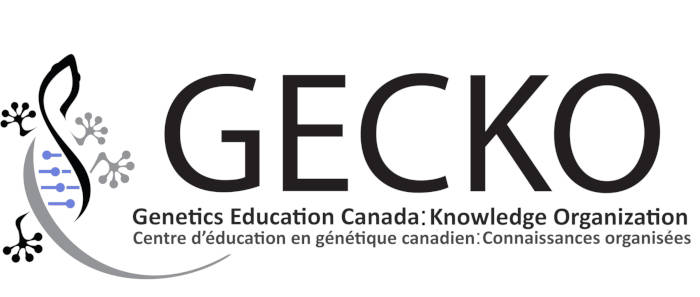Download the PDF here. Click here to view the concise GECKO on the run or the point of care tool.
|
Bottom line: Heritable thoracic aortic disease (HTAD) accounts for 20-25% of thoracic aortic aneurysms and dissections. Most individuals with HTAD do not have additional associated features (non-syndromic). HTAD presents at a younger age and is more aggressive than other thoracic aortic aneurysms (TAA). Appropriate recognition of HTAD allows initiation of imaging surveillance in at-risk relatives. Genetic testing should be offered to individuals with TAA who have at least one of the following red flags:
|
Key definitions
Dilation: when the diameter of the aorta exceeds the norms for a given age and body size. Reported as borderline, mild, moderate or severe on imaging.
Aneurysm: a dilation >50% larger than the blood vessel should be. All aneurysms are dilations, however not every dilation will reach the size of an aneurysm.
Dissection: a rip or tear in the inner lining of a blood vessel.
Degenerative: an aneurysm caused by the deterioration of a blood vessel over time, associated with risk factors such as high blood pressure and age.
What is heritable thoracic aortic disease (HTAD)?
Approximately 75% of thoracic aortic aneurysms (TAA) do not have a strong heritable component. Most are degenerative and are primarily caused by age and hypertension. TAA may also have infectious/inflammatory and traumatic etiologies.
Approximately 25% of TAA are heritable. About 20% of individuals with a TAA have no additional associated features (non-syndromic) but do have a positive family history. Five percent of individuals with TAA will have a syndromic condition (e.g. Marfan syndrome, Loeys-Dietz syndrome, vascular Ehlers-Danlos Syndrome (EDS)). These persons may be the first individual with this condition (de novo) in their family.
Individuals with HTAD typically present at a younger age and have more aggressive disease than individuals with degenerative TAA. However, the age of onset, even within members of the same family, can be variable. Both those assigned male and those assigned female at birth can be affected.
TAA are typically asymptomatic but can lead to aortic dissections. Emergency aortic repair is associated with a 50% mortality. Individuals diagnosed with a TAA prior to dissection can benefit from pharmacotherapy, lifestyle modification and, if required, elective surgical repair (associated with a 1-2% mortality rate).
Imaging is required for diagnosis of a TAA. Interpretation of the dimensions of the aortic root should take into account age, sex, height and weight. Echocardiogram assesses the aortic root and the proximal portion of the ascending aorta. CT-angiogram and MR-angiogram of the chest assess the entire thoracic aorta. In order to assess the aortic root accurately, images need to be cardiac-gated (synchronized with heartbeat to control for motion artifacts). The choice of imaging modality will depend on the arterial region at risk. In individuals with a confirmed diagnosis of TAA, a combination of echocardiogram and CT/MRI is often used, with surgical decisions being based on CT/MRI data.
Certain co-morbidities are more common in patients with HTAD. These include for example: migraine headaches, sleep apnea, and joint hypermobility.
What do I need to know about the genetics of HTAD?
In most families, HTAD is inherited in an autosomal dominant fashion, which means first degree relatives of an affected individual are at 50% risk. Multiple genes are associated with HTAD. Current genetic testing for HTAD only identifies about 20% of disease-causing gene variants. Most individuals will receive a negative genetic test result, but this does not rule out a heritable condition. Genetic testing is always initiated in an affected individual in the family, the person most likely to have the heritable condition.
How common is HTAD?
The prevalence of TAA is approximately 6-10 individuals per 100,000, which means that 1-2 people per 100,000 have the heritable type [HTAD]. This is likely an underestimate as a thoracic aortic dissection presents remarkably similarly to a myocardial infarction and can be missed.
Who to consider referring for a genetic assessment?
 Click here to download our tool for quick reference to use at the point of care.
Click here to download our tool for quick reference to use at the point of care.
Consider referral for a genetic assessment for individuals with a:
- Thoracic aortic dilation reported on imaging as mild or greater, at age <50y or <60y in the absence of hypertension
- Thoracic aortic dissection at age <60y or <70y in the absence of hypertension
-
Thoracic aortic dilation reported on imaging as mild or greater, at any age in the presence of any of the following family histories in a 1st or 2nd degree relative:
- TAA or thoracic aortic dissection
- Sudden cardiac death at age <50y without a confirmed alternate etiology
- Personal or family history of thoracic aortic dilation or TAA at any age, and features that suggest an underlying syndromic condition, such as:
-
- Tall for family (or tall and from a family where individuals with aneurysms tend to be significantly taller than those without aneurysms)
- Ectopia lentis (lens dislocation)
- Spontaneous pneumothorax (particularly if recurrent)
- Hypertelorism (wide-spaced eyes)
- Bifid uvula
- Hollow organ rupture e.g. uterus, colon
- Spontaneous tendon rupture
- Large and unprovoked bruising (prior to anti-coagulation)
- Very translucent skin
- Pectus carinatum or significant pectus excavatum
- Scoliosis requiring bracing or surgery
- Significant varicose veins at a young age
- 1st or 2nd degree relative in whom a pathogenic or likely pathogenic variant in one of the heritable thoracic aortic disease (HTAD) genes has been identified (referral of 3rd degree relatives can be considered when intervening relatives are not available for or decline testing)
Currently the decision to offer genetic testing is made in the setting of a genetics and/or cardiology consult. Click here to connect to your local genetics centre. Most genetic testing for HTAD is panel-based, where multiple genes are tested concurrently.
How do I refer my patient?
Click to connect to your local genetics centre.
Information which should be included with your referral:
- Recent echocardiogram report
- Results of genetic testing/copy of the genetic testing report in family members if applicable
-
If available:
- other imaging results (CT/MRI)
- copy of any relevant consultations (ophthalmology, etc.)
Note that cardiogenetics/general genetics centres vary with regard to the referrals they accept. You may want to contact your local genetics centre or cardiogenetics program for more information.
What does the genetic test result mean?
The detection rate of genetic testing for heritable thoracic aortic disease (HTAD) is approximately 20%, which means that 80% of individuals with HTAD will not receive an informative (positive) result. Test results fall into three categories:
Positive: causative pathogenic or likely pathogenic variant detected in a HTAD gene
-
This confirms a genetic etiology and a diagnosis of HTAD.
-
These results can be used to guide management (e.g. pharmacotherapy such as beta-blocker blocker to limit aneurysmal dilation and avoidance of fluoroquinolones, determine vascular regions which require ongoing imaging surveillance and influence surgical threshold).
-
Genetic testing can be offered to relatives for the familial gene variant. Those identified to be at-risk can be referred to an aortic clinic (preferably) or to cardiology for assessment.
Negative
Uninformative: no causative pathogenic variant detected in any HTAD gene tested
-
A diagnosis of HTAD is neither confirmed nor ruled out.
-
Genetic testing cannot be offered to unaffected relatives.
-
Over time, a better test may become available and re-referring to genetics can be considered in approximately 5 years.
True negative: the familial pathogenic/ likely pathogenic variant is not detected
-
This is where genetic testing is offered to an unaffected relative after the causative pathogenic gene variant has been identified.
-
The individual does not have the familial condition and is not at increased risk to develop thoracic aortic aneurysms (TAA).
-
This individual’s offspring would not have increased risk for TAA.
Variant of unknown significance (VUS): variant in HTAD-related gene is detected, but there is insufficient evidence to determine if it is truly associated with disease. (It is possible for more than one VUS to be detected.)
-
Depending on the variant and gene, additional imaging might be recommended to better assess for other clinical manifestations.
-
The genetics team may offer testing to other relatives affected with TAA to see if the variant is present in those with disease and absent in unaffected relatives (segregation study).
-
Over time, additional information about the variant may become available and re-referring to genetics can be considered in approximately 5 years.
Visit the GECKO site to find more resources on genetic test results including a point of care tool.
How will genetic testing help me and my patient?
Genetic testing for heritable thoracic aortic disease (HTAD) can help to:
-
Determine at what frequency imaging surveillance is needed and for which arterial beds.
-
Guide surgical threshold for aortic repair (recommendations for surgical thresholds vary depending on the underlying responsible gene).
-
Select the best medication for treatment.
-
Decide who in a family needs to continue to undergo imaging surveillance.
-
Assist with life planning (e.g., decisions about career, participation in competitive sports).
-
Provide relief to those who test negative for a known family variant.
Are there harms or limitations of genetic testing?
Current genetic testing for HTAD will only identify a causative pathogenic gene variant in about 20% of cases. Genetic testing can result in:
-
Adverse psychological reactions, particularly due to potential for risk of sudden cardiac death
-
Uncertainty due to a genetic variant of unknown significance
Surveillance and Management
Fluoroquinolones should be avoided as much as possible in anyone with aortic aneurysms or at risk for aortic aneurysm (thoracic or not, heritable or not), because of the associated increased risk of aortic dissection.
For individuals with a thoracic aortic aneurysm (TAA):
Management in terms of frequency of imaging, pharmacotherapy, vascular regions requiring ongoing imaging surveillance and surgical threshold will be influenced by the underlying gene (and sometimes the underlying variant). Pharmacotherapy typically includes a beta-blocker or an angiotensin receptor blocker to limit aneurysmal dilation.
Individuals with TAA are usually advised against participation in competitive sports and told to avoid isometric exercises. Some medications with a potent vasoactive effect (e.g. triptans) are discouraged in individuals with TAA.
Individuals with HTAD should be referred to an aortic clinic (preferably) or to a cardiologist.
For individuals with a family history of HTAD:
Transthoracic echocardiography (TTE) is the primary imaging tool for screening of family members. CT or MRI at initial evaluation would also be recommended to exclude the presence of aneurysms if visualization of a region poorly visualized by TTE is indicated. Family history (e.g. aneurysm outside thoracic aorta, intracranial aneurysm) may guide additional screening recommendations.
When a disease-causing variant is identified in a family member with TAA, at-risk relatives can be offered predictive genetic testing. The question of when to test children will depend on the specific gene.
All 1st degree relatives of an affected person should have regular surveillance unless they test negative for a known disease-causing familial genetic variant. The specific surveillance will depend on the underlying gene identified in the family. Individuals who test positive for the familial variant should be referred to an aortic clinic (preferably) or to cardiology and genetics.
Individuals who test positive for the familial variant and have not developed aortic dilatation typically do not have exercise restriction, but careful consideration should be paid before an at-risk individual constructs a life plan around activities (e.g. high-level competitive sports) which would become contra-indicated should they develop aortic dilatation.
When no disease-causing variant is identified in the family, first degree relatives of anyone in the family with a thoracic aortic aneurysm need ongoing imaging surveillance. Screening can start at age 25 years or 10 years earlier than the earliest diagnosis. The question of when to initiate screening in children will depend on the earliest age of diagnosis/onset in the family.
Surveillance typically consists of an echocardiogram (provided the region at-risk can be visualized by echocardiogram), which, if normal, should be repeated every 5 years until at least 65 years of age.
What about abdominal aortic aneurysm (AAA)?
AAA is more common in the general population and is much more strongly associated with traditional risk factors for coronary artery disease. AAA is less likely to be associated with a strong genetic predisposition than TAA, however, some conditions predisposing to HTAD can also predispose to AAA. In this context, aneurysms outside of the thoracic aorta are still considered pertinent if there is a family or personal history of TAA.
Guidelines on whom to screen for AAA have been published elsewhere.
Resources
Heritable Thoracic Aortic Disease Infographic - https://www.ottawacvgenetics.ca/_files/ugd/41e98c_0d72889e17de46b59ef24ea668fd1c15.pdf
Genetic Aortic Disorders Association Canada (GADA)
-
Resources and aortopathy clinics across Canada - https://www.gadacanada.ca/clinics-across-canada-1
Links to patient resources
Canadian genetics centres –
-
If looking to see if there is a cardiogenetics/cardiogenomics or cardiovascular specialty in your area, use the Ctrl +F function to search the page.
References
-
Boodhwani et al. Canadian Cardiovascular Society position statement on the management of thoracic aortic disease. Can J Cardiol. 2014 Jun;30(6):577-89
-
McLure et al. The aortic team model and collaborative decision pathways for the management of complex aortic disease: Clinical practice update from the Canadian Cardiovascular Society/Canadian Society of Cardiac Surgeons/Canadian Society for Vascular Surgery/Canadian Association for Interventional Radiology. Canadian Journal of Cardiology Volume 39 2023
-
Isselbacher et al. 2022 ACC/AHA guideline for the diagnosis and management of aortic disease: A report of the American Heart Association/American College of Cardiology Joint Committee on Clinical Practice Guidelines. Circulation. 2022;146:e334–e482
-
Verhagen et al. Expert consensus recommendations on the cardiogenetic care for patients with thoracic aortic disease and their first-degree relatives. Int J Cardiol. 2018 May 1;258:243-248
-
Rawla et al. Fluoroquinolones and the Risk of Aortic Aneurysm or Aortic Dissection: A Systematic Review and Meta-Analysis. Cardiovasc Hematol Agents Med Chem. 2019;17(1):3-10
-
Food and Drug Administration Drug Safety Communication. December 2018. FDA warns about increased risk of ruptures or tears in the aorta blood vessel with fluoroquinolone antibiotics in certain patients. https://www.fda.gov/drugs/drug-safety-and-availability/fda-warns-about-increased-risk-ruptures-or-tears-aorta-blood-vessel-fluoroquinolone-antibiotics [Accessed Feb 2024]
-
Canadian Task Force on Preventive Health Care. Recommendations on screening for abdominal aortic aneurysm in primary care. CMAJ 2017;189(36):E1137-E1145 https://www.cmaj.ca/content/189/36/E1137
Authors: J Richer MD FCCMG FRCPC, JC Carroll MD CCFP, JE Allanson MD FRCPC, S Walji MD CCFP MPH, S Morrison MS CGC




